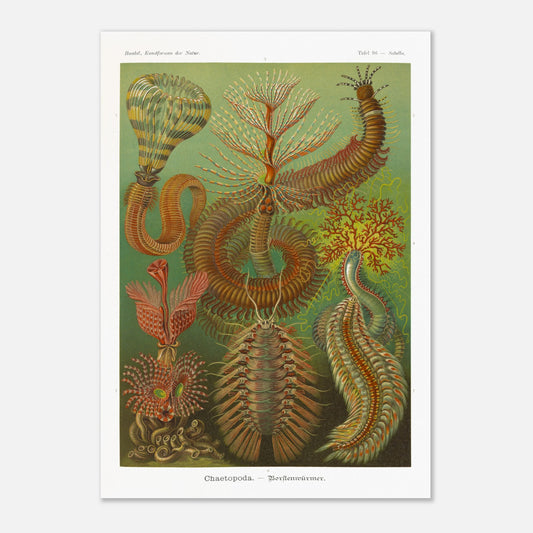Polychaetes - Detailed illustration of nature - Ernst Haeckel, Kunstformen der Natur
Polychaetes - Detailed illustration of nature - Ernst Haeckel, Kunstformen der Natur
Couldn't load pickup availability
Reproduction engraving of: Polychaetes
Original title Chaetopoda - Borstenreichen
Sabella Poster - Arthropods of the main class Annelida (Annelida), Class Polychaeta (Chaetopoda)
Illustration from the book Kunstformen der Natur, which is a collection of artistic lithographs of natural sciences published by the German biologist Ernst Haeckel between 1899 and 1904.
This naturalistic illustration is part of an overall style inspired by Ernst Haeckel, which greatly influenced the emerging Art Nouveau movement at the beginning of the 20th century. This work, illustrating the impressive beauty and great diversity of the biological world, was complemented by a certain amount of scientific information, some excerpts of which are reproduced below.
This information is over 120 years old and some of it may be outdated!
Scientific classification:
Phylum of Arthropods (Articulata) Main class of Ringed Worms (Annelida) Class Chetopods (Chaetopoda) Subclass of Polychaeta.
Scientific notice (extract) accompanying the poster print of Chaetopoda - Polychaetes :
The ringed worms, or Annelida, are generally considered a class of "worms," but they are clearly distinguished from the true unsegmented worms (Vermes, see Tables 23, 32, 33, 97) by their metamerism, that is, by the external and internal segmentation of their elongated bodies. In this respect, they are more similar to the higher "arthropods" (Arthropoda), the two form-rich groups of crustaceans (Crustacea, see Tables 56, 76) and tracheates (Tracheata, see Tables 58, 66). What is common to all these arthropods (Articulata) is not only the external segmentation of the cuticle, but also the internal organization of the central nervous system (medullary), myointestinal, vascular, etc. The ancient annelates are distinguished from the two more recent groups of arthropods mainly by the fact that the meromeres or individual body segments (segmenta, somita, metameres) in the former are often very uniform (homonomous), while in the latter they are more or less heterogeneous (heteronomous) due to the division of labor. Similarly, in annelates the legs (originally one pair per segment) are short and unjointed, while in most arthropods they are long and jointed. The main class of annelates is divided into two subclasses, the leeches or Hirudinea and the bristleworms or Chaetopoda. The skin of the former is smooth and devoid of setae, which distinguishes the latter. These chitinous setae are extremely varied in shape, size, and arrangement. They are small and poorly developed in the sparsely populated bristleworms (Oligochaeta), which include the earthworm (Lumbricus), among others. In contrast, they are large and numerous in the bristle-rich bristleworms (Polychaeta), where they are located on special feet (parapodia) absent in the sparsely populated bristleworms. Usually, two pairs of crotch feet are present on each body segment, sometimes with only one pair. The feet usually bear external gills, sensory filaments, and other appendages. The bristleworms (Polychaeta) all live in the sea and are divided into two form-rich orders: the predatory worms and the tubeworms. The predatory worms (Errantia or Rapacia, Fig. 5-7) move freely in the sea by crawling or swimming and bear gills on most segments. As voracious predators, they have a well-developed head, often armed with mandibles. On the other hand, tubeworms (Tubicolae or Sedentaria, Fig. 1-4) live attached to the seabed; their head is rudimentary and bears large gills, but they do not have mandibles.
Species present on the Polychaeta - Sabella naturalist board :
- Sabella spectabilis
- Serpula contortuplicata
- Spirographis spallanzanii
- Terebella emmalina
- Eunice Magnifica
- Hermione hystricella
- Chloëia euglochis
About this print
About this print
The layout and composition of this reproduction have been the subject of our greatest attention.
- Respect for the format of the original work: in order to faithfully transcribe the artist's intention, the work is not cropped/re-cut except in extreme cases (obvious imperfection, geometry problem, etc.) in which case the cropping will be as light as possible.
- The presence of white margins is sometimes necessary in order to present the work in a balanced manner.
- Each size offered has been specifically composed, therefore, the size of the white margins may vary from one print size to another. Remember to check this detail carefully!
- Print only, frame not included!
Features
Features
- Premium 200gsm matte white paper, durable and strong.
- Natural, smooth uncoated finish, silky to the touch
- FSC certified paper or equivalent certifications depending on regional availability.
- Each print is shipped in sturdy packaging, ensuring safe transport.
- Each print is printed and shipped on demand. No minimum order quantity is required.
Share !









Recently viewed products
We are listening to you
If you are looking for a specific composition, a particular layout, or any other customization need, our team is at your disposal and will do everything possible to meet your requests.
So don't hesitate to...




